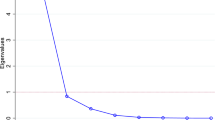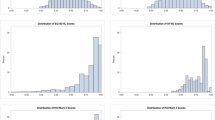Abstract
Objective: This study investigated the feasibility and usefulness of linking algorithms for well known quality-of-life (QOL) indicators to large nationally representative databases.
Design and Setting: The National Medical Expenditure Survey (NMES) was utilised. We developed an algorithm to match the EuroQOL health indicator and drew on a previous match of the Health Utilities Index (HUI) in a companion paper. This process allowed the sensitivity and detail of health-related quality-of-life (HR-QOL) indicators to be combined with the benefits of large, nationally representative data sets.
Patients and participants: A total of 19 525 individuals aged 18 years and older (constituting a nationally representative sample of the non-institutionalised civilian population of the US contained within the 1987 NMES database) were investigated.
Interventions: Sensitivity analyses using several related specifications of each indicator were performed. We analysed the correlations of these alternatives for both the HUI and EuroQOL measures. Correlations between the HUI and EuroQOL measures were also examined. We investigated the construct validity by examining the performance of the HUI and EuroQOLs in empirical situations in which we had knowledge about the relationships (e.g. health decreases with age).
Main outcome measures and results: The benefits of HR-QOL measures can be achieved relatively cheaply and efficiently via linking rather than developing a large scale QOL survey. Although the NMES data allowed a good match with the EuroQOL and the HUI, the matches were not perfect. By examining the within-domain correlations and the between-domain correlations, we found that the alternate specifications within-domain were very similar and that the 2 HRQOL indicators were comparable in many (but not all) aspects.
Conclusions: The results of this study suggested good construct validity. Thus, linked HR-QOL measures of the types derived in this study may be useful in characterising the health of large populations, and in investigating the causes and consequences of health.
Similar content being viewed by others
References
Berthelot J-M, Roberge R, Wolfson M. The calculation of health-adjusted life expectancy for a Canadian province using a multi-attribute utility function: a first attempt. In: Robine JM, Mathers CD, Bone MR, et al., editors. Calculation of health expectancies: harmonization, consensus achieved and future perspectives. Montrouge, France: Colloque INSERM/John Libbey Eurotext Ltd., 1993; 226: 161–72
Schipper H, Clinch JJ, Olweny CL. Quality of life studies: definitions and conceptual issues. In: Spilker B, editor. Quality of life and pharmacoeconomics in clinical trials. Philadelphia (PA): Lipincott-Raven Publishers, 1996: 11–23
Wolfson MC. Health-adjusted life expectancy. Health Rep 1996; 6 (1): 41–6
Erickson P. Modelling health-related quality of life: the bridge between psychometric and utility-based measures. J Natl Cancer Inst 1996; 20: 17–22
Rizzo JA, Pashko S, Friedkin R, et al. Linking the health utilities index to National Medical Expenditure Survey Data. Pharmacoeconomics 1998; 13 (5 Pt 1): 531–41
Gold MG, Franks P, Erickson P. Assessing the health of the nation: the predictive validity of a preference-based measure and self-rated health. Med Care 1996; 34 (2): 163–77
Saigal S, Rosenbaum P, Stoskopf B, et al. Comprehensive assessment of the health status of extremely low birthweight children at eight years of age: comparison with a reference group of children at age eight years. J Pediatr 1994a; 125 (3): 411–7
Saigal S, Feeny D, Furlong W, et al. Comparison of the health-related quality of life of extremely low birth weight children and a reference group of children at eight years. J Pediatr 1994b; 125 (3): 418–25
Curtis L. Socioeconomic status and health [thesis]. West Hamilton (ON): Department of Economics, McMaster University, 1998
Dolan P, Gudex C, Kind P, et al. A social tariff for EuroQol: results from a UK general population survey. York: Centre for Health Economics, University of York, 1995. Discussion paper no.: 138
Torrance GW, Boyle MH, Horwood SP. Application of multi-attribute utility theory to measure social preferences for health status. Oper Res 1982; 30 (6): 1042–69
Nord E. EuroQol: health-related quality of life measurement. Valuations of health states by the general public in Norway. Health Policy 1991; 18 (1): 25–36
Sculpher MJ, Dwyer N, Byford S, et al. Randomised trial comparing hysterectomy and transcervical endometrial resection: effect on health-related quality of life and costs two years after surgery. Br J Obstet Gynecol 1996; 103 (2): 142–9
Keeney RL, Raiffa H. Decisions with multiple objectives: preferences and value tradeoffs. New York: Cambridge University Press, 1993
Feeny D, Furlong W, Barr RD, et al. A comprehensive multi-attribute system for classifying the health status of survivors of childhood cancer. J Clin Oncol 1992; 10 (6): 923–8
Feeny D, Furlong W, Boyle M, et al. Multi-attribute health status classification systems: health utilities indices. Pharmacoeconomics 1995; 7 (6): 490–502
Feeny DH, Torrance GW, Furlong WJ. Health utilities index. In: Spilker B, editor. Quality of life and pharmacoeconomics in clinical trials. 2nd ed. Philadelphia (PA): Lippincott-Raven Press, 1996: 239–52
Drummond MF, O’Brien B, Stoddart GL, et al. Methods for the economic evaluation of health care programmes. 2nd ed. Oxford: Oxford University Press, 1997
Drummond MF, Stoddart GL, Torrance GW. Methods for the economic evaluations of health care programmes. Oxford: Oxford University Press, 1987
Feinstein J. The relationship between socioeconomic status and health: a review of the literature. Milbank Q 1993; 71 (2): 279–322
Ettner S. New evidence on the relationship between income and health. J Health Econ 1996; 15 (1): 67–85
Author information
Authors and Affiliations
Corresponding author
Rights and permissions
About this article
Cite this article
Rizzo, J.A., Sindelar, J.L. Linking Health-Related Quality-of-Life Indicators to Large National Data Sets. Pharmacoeconomics 16, 473–482 (1999). https://doi.org/10.2165/00019053-199916050-00005
Published:
Issue Date:
DOI: https://doi.org/10.2165/00019053-199916050-00005




